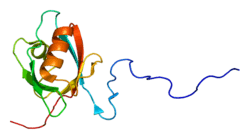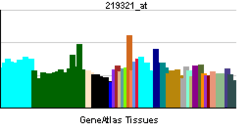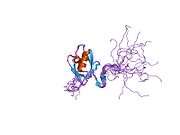MPP5
| View/Edit Human | View/Edit Mouse |
MAGUK p55 subfamily member 5 is a protein that in humans is encoded by the MPP5 gene.[3][4]
Members of the peripheral membrane-associated guanylate kinase (MAGUK) family function in tumor suppression and receptor clustering by forming multiprotein complexes containing distinct sets of transmembrane, cytoskeletal, and cytoplasmic signaling proteins. All MAGUKs contain a PDZ-SH3-GUK core and are divided into 4 subfamilies, DLG-like (see DLG1; MIM 601014), ZO1-like (see TJP1; MIM 601009), p55-like (see MPP1; MIM 305360), and LIN2-like (see CASK; MIM 300172), based on their size and the presence of additional domains (Tseng et al., 2001). MPP5 is a member of the p55-like MAGUK subfamily.[supplied by OMIM][4]
Interactions
MPP5 has been shown to interact with INADL and FAM71D.[3]
References
- ↑ "Human PubMed Reference:".
- ↑ "Mouse PubMed Reference:".
- 1 2 Roh MH, Makarova O, Liu CJ, Shin K, Lee S, Laurinec S, Goyal M, Wiggins R, Margolis B (Apr 2002). "The Maguk protein, Pals1, functions as an adapter, linking mammalian homologues of Crumbs and Discs Lost". J Cell Biol. 157 (1): 161–72. doi:10.1083/jcb.200109010. PMC 2173254
 . PMID 11927608.
. PMID 11927608. - 1 2 "Entrez Gene: MPP5 membrane protein, palmitoylated 5 (MAGUK p55 subfamily member 5)".
Further reading
- Andersson B, Wentland MA, Ricafrente JY, et al. (1996). "A "double adaptor" method for improved shotgun library construction.". Anal. Biochem. 236 (1): 107–13. doi:10.1006/abio.1996.0138. PMID 8619474.
- Yu W, Andersson B, Worley KC, et al. (1997). "Large-scale concatenation cDNA sequencing.". Genome Res. 7 (4): 353–8. doi:10.1101/gr.7.4.353. PMC 139146
 . PMID 9110174.
. PMID 9110174. - Kamberov E, Makarova O, Roh M, et al. (2000). "Molecular cloning and characterization of Pals, proteins associated with mLin-7.". J. Biol. Chem. 275 (15): 11425–31. doi:10.1074/jbc.275.15.11425. PMID 10753959.
- Hartley JL, Temple GF, Brasch MA (2001). "DNA cloning using in vitro site-specific recombination.". Genome Res. 10 (11): 1788–95. doi:10.1101/gr.143000. PMC 310948
 . PMID 11076863.
. PMID 11076863. - Wiemann S, Weil B, Wellenreuther R, et al. (2001). "Toward a catalog of human genes and proteins: sequencing and analysis of 500 novel complete protein coding human cDNAs.". Genome Res. 11 (3): 422–35. doi:10.1101/gr.GR1547R. PMC 311072
 . PMID 11230166.
. PMID 11230166. - Simpson JC, Wellenreuther R, Poustka A, et al. (2001). "Systematic subcellular localization of novel proteins identified by large-scale cDNA sequencing.". EMBO Rep. 1 (3): 287–92. doi:10.1093/embo-reports/kvd058. PMC 1083732
 . PMID 11256614.
. PMID 11256614. - Tseng TC, Marfatia SM, Bryant PJ, et al. (2001). "VAM-1: a new member of the MAGUK family binds to human Veli-1 through a conserved domain.". Biochim. Biophys. Acta. 1518 (3): 249–59. doi:10.1016/s0167-4781(01)00191-9. PMID 11311936.
- Strausberg RL, Feingold EA, Grouse LH, et al. (2003). "Generation and initial analysis of more than 15,000 full-length human and mouse cDNA sequences.". Proc. Natl. Acad. Sci. U.S.A. 99 (26): 16899–903. doi:10.1073/pnas.242603899. PMC 139241
 . PMID 12477932.
. PMID 12477932. - Makarova O, Roh MH, Liu CJ, et al. (2003). "Mammalian Crumbs3 is a small transmembrane protein linked to protein associated with Lin-7 (Pals1).". Gene. 302 (1–2): 21–9. doi:10.1016/S0378111902010843. PMID 12527193.
- Hurd TW, Gao L, Roh MH, et al. (2003). "Direct interaction of two polarity complexes implicated in epithelial tight junction assembly". Nat. Cell Biol. 5 (2): 137–42. doi:10.1038/ncb923. PMID 12545177.
- Roh MH, Fan S, Liu CJ, Margolis B (2004). "The Crumbs3-Pals1 complex participates in the establishment of polarity in mammalian epithelial cells". J. Cell. Sci. 116 (Pt 14): 2895–906. doi:10.1242/jcs.00500. PMID 12771187.
- Ota T, Suzuki Y, Nishikawa T, et al. (2004). "Complete sequencing and characterization of 21,243 full-length human cDNAs". Nat. Genet. 36 (1): 40–5. doi:10.1038/ng1285. PMID 14702039.
- Penkert RR, DiVittorio HM, Prehoda KE (2004). "Internal recognition through PDZ domain plasticity in the Par-6-Pals1 complex". Nat. Struct. Mol. Biol. 11 (11): 1122–7. doi:10.1038/nsmb839. PMC 2140275
 . PMID 15475968.
. PMID 15475968. - Gerhard DS, Wagner L, Feingold EA, et al. (2004). "The status, quality, and expansion of the NIH full-length cDNA project: the Mammalian Gene Collection (MGC)". Genome Res. 14 (10B): 2121–7. doi:10.1101/gr.2596504. PMC 528928
 . PMID 15489334.
. PMID 15489334. - Wiemann S, Arlt D, Huber W, et al. (2004). "From ORFeome to biology: a functional genomics pipeline". Genome Res. 14 (10B): 2136–44. doi:10.1101/gr.2576704. PMC 528930
 . PMID 15489336.
. PMID 15489336. - Stöhr H, Molday LL, Molday RS, et al. (2005). "Membrane-associated guanylate kinase proteins MPP4 and MPP5 associate with Veli3 at distinct intercellular junctions of the neurosensory retina". J. Comp. Neurol. 481 (1): 31–41. doi:10.1002/cne.20367. PMID 15558731.
- Feng W, Long JF, Zhang M (2005). "A unified assembly mode revealed by the structures of tetrameric L27 domain complexes formed by mLin-2/mLin-7 and Patj/Pals1 scaffold proteins". Proc. Natl. Acad. Sci. U.S.A. 102 (19): 6861–6. doi:10.1073/pnas.0409346102. PMC 1100767
 . PMID 15863617.
. PMID 15863617. - Kantardzhieva A, Gosens I, Alexeeva S, et al. (2005). "MPP5 recruits MPP4 to the CRB1 complex in photoreceptors". Invest. Ophthalmol. Vis. Sci. 46 (6): 2192–201. doi:10.1167/iovs.04-1417. PMID 15914641.
- Mehrle A, Rosenfelder H, Schupp I, et al. (2006). "The LIFEdb database in 2006". Nucleic Acids Res. 34 (Database issue): D415–8. doi:10.1093/nar/gkj139. PMC 1347501
 . PMID 16381901.
. PMID 16381901.



